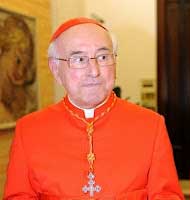|
 Today Vatican Insider published an
interview
with Cardinal Walter Brandmüller, a Church historian and scholar of
the Second Vatican Council, on the Golden Jubilee of Vatican II. Today Vatican Insider published an
interview
with Cardinal Walter Brandmüller, a Church historian and scholar of
the Second Vatican Council, on the Golden Jubilee of Vatican II.
A few points to consider:
1.) Cardinal Brandmüller compares the confusion after
Vatican II to the period after the Council of Nicea as
evidence that what we are experiencing is not without
precedent. However, the Council of Nicea, unlike Vatican
II, defined dogma. Thus one either accepted the dogma
defined at Nicea or one was a heretic. Any arguments in
the period following the Council of Nicea were between
heretics and Catholics, not Catholics arguing amongst
themselves about ambiguous pastoral language used by the
Council.
2.) The Cardinal claims that the Council of Trent took
fifty years to bear fruit and thus, we should allow more
“breathing space” in waiting for the fruits of Vatican
II. However, what Cardinal Brandmüller does not point
out is that the Council of Trent took place in the
1500's after years of Magisterial neglect allowing the
Protestant heresy to ravage Europe. Thus the Council of
Trent’s task to revive the Church was a daunting one. In
contrast, Vatican II occurred in a time of great success
for the Church to the point where many questioned the
very need for a Council. In addition, the Council of
Trent took place in a time before wide-spread access to
books, when there was no faster transportation than
horseback, and there was snail's pace communication.
Despite this, Cardinal Brandmüller
admits that the Council of Trent needed a mere
fifty years to bear fruit! This admission, far from
absolving the amount of fruitless time since Vatican II,
only serves as a further indictment of Vatican II. For
the Vatican Council has borne no substantial fruit since
1965: a period which enjoyed widespread access to
information, instantaneous communication, and access to
rapid travel.
3.) Cardinal Brandmüller
states, "The language that was used during [VCII]
and the completeness of the texts show that the Council
fathers were not as much motivated by the need to pass
judgment on controversial new ecclesiastical and
theological issues, but rather by the wish to turn their
attention to public opinion within the Church and the
entire world, in the spirit of the annunciation." This
is precisely the problem. The Council of Trent was
clear. It condemned error. It produced a clear Catechism
and canonized a clear Catholic Mass for all time. There
was no "spirit of Trent," there was the Council of
Trent. All that was needed to "implement” Trent was to
more or less do what it said to do. Vatican II is
incapable of being implemented precisely because nobody
knows what it is they are supposed to implement. Vatican
II is a mish mash of pastoral ambiguous language which
is left to the interpretation of the implementers.
4.) Cardinal Brandmüller was asked what fruits the
Second Vatican Council produced. But instead of listing
fruits of the Council (tangible results from the
Council which benefitted the Church) the Cardinal lists
two documents which resulted from the Council:
the Catechism of the Catholic Church and the New Code of
Canon Law. Thus we must look to the fruits of these two
resulting documents. The purpose of a Catechism is to
teach Catholic doctrine to the faithful. Has the
knowledge of Catholic doctrine among the faithful
increased or decreased since Vatican II? As for the Code
of Canon Law, its primary purpose is to enforce
discipline in the Church. Has ecclesiastical discipline
of dissenting clergy or bishops increased or decreased
after Vatican II? Thus, it appears the two results of
the Council the Cardinal names have themselves borne no
recognizable fruit for the Church.
5.) Finally, to his credit, Cardinal Brandmüller does
not list the post-conciliar liturgy as a fruit of
Vatican II, but instead criticizes it as not coming from
the Council. He states, “I
must emphasise that the form of the post-conciliar
liturgy with all its distortions, is not attributable to
the Council or to the Liturgy Constitution established
during Vatican II which by the way has not really been
implemented even to this day. The indiscriminate removal
of Latin and Gregorian Chants from liturgical
celebrations and the erection of numerous altars were
absolutely not acts prescribed by the Council.” Although
the Cardinal is correct in stating that certain
distorted liturgical practices were not explicitly
prescribed by Vatican II, the ambiguous and at times
seemingly contradictory language of
Sacrosanctum Concilium allowed for these distortions.
What is more, the post-conciliar papal approval given to
novel practices like Communion in the hand, female altar
servers, and Mass facing the people served to reinforce
the idea that these practices are a legitimate
implementation of the Vatican II liturgy. |
